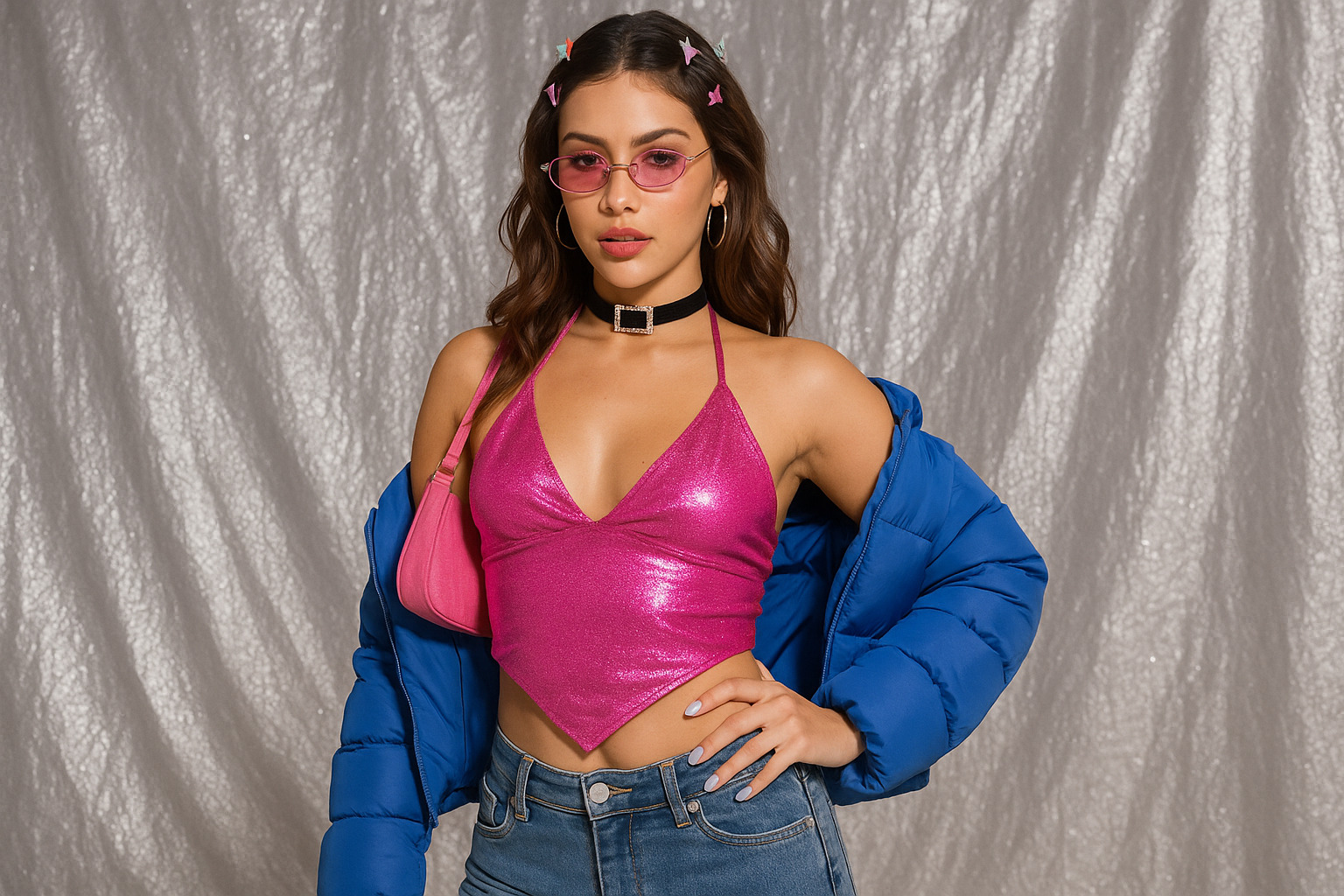Y2K fashion refers to the stylistic era spanning from the late 1990s to the early 2000s, roughly between 1997 and 2004. Defined by its flashy materials, futuristic inspirations, and pop culture influence, it mirrored the cultural mindset leading up to and following the turn of the millennium. The aesthetic combined tech enthusiasm with bold expression, drawing from the digital boom, music video aesthetics, and celebrity culture.
The Driving Forces Behind Y2K Fashion
1. Technological Influence
The rise of the internet and the obsession with the new millennium shaped Y2K fashion in every aspect. Clothing mimicked the surfaces of gadgets—slick, synthetic, shiny.
- Fabrics: PVC, patent leather, metallics, and iridescent textiles.
- Colors: Neon greens, bubblegum pinks, icy silvers, and pixel-inspired patterns.
- Motifs: Digital prints, pixel art, and outer-space designs.
2. Music Culture and MTV
Artists like Britney Spears, Christina Aguilera, Destiny’s Child, *NSYNC, and Backstreet Boys weren’t just dominating the charts—they were shaping closets.
- Outfits from music videos became templates for everyday wear.
- Coordinated ensembles, midriff-baring tops, and low-rise bottoms proliferated.
- High production value videos inspired the era’s futuristic and theatrical vibe.
3. Reality TV and Celebrity Style
Paris Hilton, Nicole Richie, Lindsay Lohan, and Mischa Barton were paparazzi darlings, and their looks became the foundation of street style.
- Red carpet and street snapshots were pored over for inspiration.
- The “It Girl” phenomenon led to massive replication of individual style choices.
- Designer labels and logo-centric items gained traction.
4. Hip-Hop and Streetwear
Brands like Baby Phat, Rocawear, and FUBU influenced the fashion mainstream.
- Oversized jerseys, flashy accessories, and baggy silhouettes merged with pop style.
- Sneakers became statement pieces.
- Streetwear and glam aesthetics often coexisted in one look.
5. Global Style Sampling
Designers and fast fashion brands began incorporating eclectic elements.
- Asian-inspired prints, bohemian textures, and culturally inspired silhouettes surfaced.
- These often lacked authenticity but still left a visible imprint on the era’s wardrobe.
Key Garments That Defined the Era
Tops
- Baby Tees: Fitted, often bearing logos or cheeky slogans.
- Crop Tops: Strapless, halter, or camisole styles showing off the midriff.
- Halter Tops: Often in metallic or glittery fabrics.
- Mesh Tops: Transparent and often layered.
- One-Shoulder Tops: Adding asymmetry to the mix.
- Argyle Sweaters: Brought in a splash of preppy.
Bottoms
- Low-Rise Jeans: Ultra-low with bootcut or flared legs.
- Cargo Pants: Pockets, zippers, and utility-focused details.
- Mini Skirts: Denim, pleated, and often paired with knee-high boots.
- Capris: Cut at the calf, common in pastel and khaki.
- Velour Tracksuits: Often matching, popularized by Juicy Couture.
Dresses
- Slip Dresses: Often worn over tees or on their own.
- Handkerchief Hem Dresses: Asymmetry made fashionable.
- Bodycon Dresses: Tight-fitting with bold colors and cuts.
Outerwear
- Cropped Denim Jackets: Embellished or distressed.
- Puffer Vests: Especially in bright or metallic finishes.
- Faux Fur Coats: Lux meets street.
Footwear
- Chunky Sneakers: Skechers, Buffalo, and other platform-heavy designs.
- Platform Sandals: Heeled flip-flops with loud colors.
- Pointed-Toe Heels: Often in glossy patent leather.
- Ugg Boots: Cozy yet controversial.
Accessories That Completed the Look
- Baguette Bags: Small, shoulder-hugging purses.
- Tiny Sunglasses: Often tinted and rimless.
- Butterfly Clips: Used in patterns or randomly scattered.
- Bandanas: Tied as headbands or folded around ponytails.
- Bucket Hats: Bright and often denim.
- Chokers: Plastic tattoos, velvet bands, or rhinestone-studded.
- Body Glitter: Applied to arms, cheeks, or décolletage.
- Trucker Hats: With mesh backs and graphic fronts.
- Phone Charms: Dangling decor for flip phones.
Social Context and Criticism
Y2K fashion emerged during a time of optimism. The dot-com era, relatively strong economies, and cultural shifts contributed to a generation experimenting with style. Clothing was fun, self-expressive, and often body-centric.
But not everyone benefited from this aesthetic. The trend was heavily skewed toward a narrow body ideal. Ultra-low-rise jeans, visible thongs, and skin-tight garments were rarely marketed toward diverse sizes or body types. Critics have pointed to the unrealistic beauty standards promoted during this time.
Why It’s Back—and What’s Different Now
The Y2K revival kicked off around 2020, driven by TikTok, nostalgia, and the growing interest in thrifting.
Reasons for the Return
- Nostalgia: Those who grew up during the Y2K era are now adults, driving the trend’s resurgence.
- TikTok Trends: Style tutorials, thrift hauls, and “get ready with me” videos spotlight Y2K outfits.
- Sustainable Shopping: Vintage pieces and secondhand shopping align with the movement.
- Desire for Optimism: Colorful, playful clothing offers a break from minimalist norms.
Modern Adjustments
- Body Positivity: The trend now caters to a broader spectrum of body types.
- Mix-and-Match Styling: People pair low-rise jeans with oversized blazers or sneakers with slip dresses.
- Customization: DIY edits, thrifting, and personalization are prominent.
Differentiating Y2K From Adjacent Eras
- Late ’90s Grunge: Darker, anti-establishment, flannel-heavy. Lacked the shine and sparkle of Y2K.
- Mid-2000s Boho: Flowing skirts, fringe, and earthy tones replaced the synthetic sheen of Y2K.
- 2010s Minimalism: Monochrome palettes and sleek lines took over after the maximalism of the early 2000s.
Final Thoughts
Y2K fashion wasn’t just about clothing—it was about a mood. It was loud, unapologetic, and tightly woven into music, technology, and pop culture. The revival isn’t identical, but it borrows enough to keep the vibe alive, reimagined for a new generation that’s shaping it through thrift finds, TikTok edits, and personal creativity. Whether it’s a mesh top with cargo pants or a velour tracksuit with Uggs, the Y2K aesthetic is no longer a throwback—it’s part of the present.
